The use of 3D printers to create lab equipment, deliver reagents and even build biomaterials is on the rise. Katharine Sanderson installs drivers and prints away
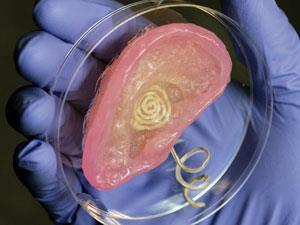
The latest piece of cool technology at the top of every self-confessed geek’s wish list is quite likely to be a 3D printer. Who wouldn’t want the wherewithal to print a range of gadgets on a whim, from plastic toys to a spare pair of glasses or even pizza?
And now seems like the perfect time to splash out on your own 3D printer: companies like MakerBot are selling 3D printers for less than $2000 (around £1300), and the original open-source communities aiming to bring 3D printing and the code needed to run it to the general public are thriving. And there’s no need to restrict printing to the home, for toys, pizza or other gimmickry. It is becoming more and more fashionable to have a 3D printer in the lab.
Much of the headline-grabbing scientific 3D printing has been in biotechnology, where body parts have been printed using biological polymers, which can then be placed in a bioreactor filled with stem cells. Those stem cells eventually take over, leaving a piece of skin, for example, or a heart valve made from the patient’s own cells. A non-functioning kidney was even printed by surgeon Anthony Atala from the Wake Forest Institute for Regenerative Medicine in the US in 2012.1
But why stop at replacement body parts? Why not go beyond biology and use 3D printing to enhance the human body? In May this year, nanotechnology, tissue engineering and 3D printing were combined to print bionic body parts – a pair of ears that could sense radio frequencies. The ears were made by 3D-printing hydrogels impregnated with living chondrocyte cells – those found in healthy cartilage. As well as printing the hydrogels and cells, a third ‘ink’ containing nanosized conducting silver was added, and a coiled antenna printed in a specific site in the middle. These ears could pick up a range of frequencies much broader than non-bionic human ears can manage, and complementary left and right ears could process stereo sound.2
Inevitably, biological applications are those that attract most attention from media and perhaps other scientists. But the role of chemistry in 3D printing, and 3D printing in chemistry, should not be underestimated.
Chemistry on demand
Why not use a 3D printer for organic synthesis? Following the unveiling of his 3D printed ‘reactionware’ in April 2012, Lee Cronin at Glasgow University in the UK is doing just this.3
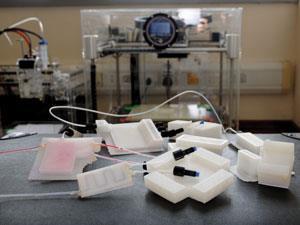
Reactionware is the term Cronin gives to his connected sequences of reaction vessels that he prints to order. The reactionware can be made functional by printing in catalysts at certain places, or including a small column for in situ purification. Cronin has so far managed to do multi-step organic syntheses with his printed reactionware4 and says he plans to release the software code needed to run these specific reactions to his website soon, in an open-source repository of reactionware. Cronin hopes that open access designs will proliferate. He sees a future where organic syntheses no longer have to be followed from a paper, with rounds of trial and error to get the reaction working in the way the authors report. Instead, a set of chemical inks could be ordered, the design for the apparatus downloaded and the reaction run automatically. ‘The liquid handling instructions can make a compound without any human interaction,’ he says. ‘It makes sure people are able to reproduce other work more quickly.’
Even though Cronin uses bathroom sealant as his material and a cheap, commercially available printer to make the reactionware,5 his ambition for the technology is that it will allow him to do new, exciting chemistry. He hopes one day to combine printed tissues with printed drug candidates, and print in a system to screen those drugs. Far in the future, these drug-making printer instructions could be dialled up by a nurse or doctor in a remote village of the developing world, to provide simple painkillers, or more complex drugs from a standard set of chemical ‘inks’, Cronin suggests.
Before that happens, the idea that 3D printing can be useful in chemistry will need to proliferate more widely, but there is already some progress from early-adopters. In April this year, another group of researchers used some clever chemistry to 3D print a synthetic material that behaves somewhat like living tissue. Hagan Bayley at the University of Oxford wanted to advance his work on making tiny devices from cell-like droplets. These droplets have a lipid layer on their outside and when two droplets join together, a lipid bilayer then forms, which holds them in place. Carefully placing the droplets together by hand allowed Bayley’s group over the years to make small batteries, circuits and light-responsive devices. But these tiny devices were laborious to make, hand-pipetting each droplet into place, and limited in size. ‘We wanted to make 3D objects that had many more droplets,’ says Bayley.
Those objects would become artificial tissues. One of Bayley’s students, Gabriel Villar, attacked the challenge by building a custom 3D printer that would print out 50 picolitre droplets. Layer by layer, the printer built a piece of tissue-like synthetic material.

The tissue can be printed to have crude functions. For example, some of the droplets have pore-forming proteins printed into them, and when those proteins link with other similar droplets, channels form. Applying a voltage across the material allows ions to flow. ‘A tissue is a collection of different cells; what it does is greater than the sum of its parts,’ says Bayley.
Another example allows the tissue to mimic muscle behaviour. The team printed different salt concentrations into different droplets. As the salt solutions move around between droplets through osmosis, the relative sizes of the droplets change and this allows the tissue to curl up – much like a muscle. ‘We could print great chunks of this material,’ says Bayley.
He sees all sorts of future applications for his 3D printed tissues, including printing enzymes into the droplets that can then make drug molecules in the body and release them at a desired location. ‘These entities have no genome, so there is no potential danger,’ he says: these artificial tissues cannot replicate or mutate.
Biomaterial bonanza
Biomaterials development with 3D printing shows wider promise. US biomedical engineer Jonathan Butcher of Cornell University in Ithaca, New York, prints heart valves. First he prints a scaffold using alginate and poly-ethylene glycol-diacrylate (PEG-DA) hydrogels which are then set in place by a UV light crosslinking method. The scaffold is then incubated in a bioreactor with aortic cells, which become integrated with the polymer hydrogel and eventually make up the printed aorta themselves.
But Butcher wants to improve the scaffolds he prints so they have better mechanical properties. The different stiffness of a hydrogel can persuade a stem cell to differentiate into a specific kind of cell. Printing hydrogels with different stiffness at different points in the same material could lead to a material that has a blueprint for stem cells to become specific other cells at those spots. ‘The idea is to fabricate a 3D tissue with not only complexity, but also with local heterogeneity,’ says Butcher.
Hydrogel expert Rein Ulijn at Strathclyde University, in Glasgow, does not do any printing of his own, but is working on a similar problem. 3D printers are very good at positional control, he says, and he sees great potential in using them to help make molecular materials with building blocks that have instructions in them – those instructions could be for stem cells, he says.
‘Tissues are not homogenous in the bulk,’ says Ulijn, and organs in particular are complex, made of many different types of cell. Like Butcher, Ulijn is developing gels that are soft or stiff. In these systems, he says, a soft gel would produce neural cells from a stem cell, whereas stiff gels could lead to bone cells. A spinout company, BioGelX has been set up to make these gels and he is already getting enquiries from other teams wanting to buy the gels to print with. ‘It’s the logical next step for us,’ says Ulijn.
His sights are set beyond replacement body parts. Ulijn is interested in making gels that might one day be the interface needed to connect biology with electronics, similar to the bionic ear. Ulijn’s team has already reported a hydrogel that interfaces with a liquid crystal, to make an optical sensor for enzyme activity.6 Printing has an integral role in developing these materials, Ulijn says. ‘Our expertise is in making the gels. To interface them with electronic devices we need control to put the gels and cells where we need them.’
Lab workhorse
For now, sophisticated uses of 3D printing, like Bayley’s tissues, Butcher’s valves and Cronin’s reactionware, are limited to a few groups, but there is no reason why a 3D printer could not play a more utilitarian role in the chemistry lab. PhD student James Bannock works with John de Mello in the Centre for Plastic Electronics at Imperial College London, UK, investigating new plastic electronics and nanomaterials. Bannock uses a 3D printer to help speed up his research.
‘There are 3D printed parts everywhere,’ he says of the de Mello labs. ‘We can make parts that would otherwise be impossible or unnecessarily time consuming,’ says Bannock, and it is especially useful when multiples of the same component are needed, he adds. These simple parts include chromatography column holders and parts to connect a fibre optic cable to a photodetector chip. But the group has also printed more sophisticated kit to help in their research, including a custom-built multi-angle light scattering instrument for determining the molecular weight of polymers.
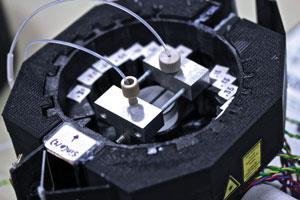
De Mello first got hold of a 3D printer to use in advanced undergraduate teaching laboratories, says Bannock. The students have to build, test and develop a simple absorption spectrophotometer – using a webcam, diffraction grating, an LED and their samples. The students have to design something that will hold each component in the best configuration for the spectrometer to work. This is made easier for the students thanks to a web-based 3D printing design tool called Sketchup. ‘The idea is to demonstrate how spectrometers work and also how to go about building your own kit,’ says Bannock. The experiment is popular with the students, and understanding how a machine works from the bottom up, as well as the satisfaction of building something useful oneself is part of this appeal, Bannock says.
While Cronin manages to print his reactionware using bathroom sealant as the basic ink, others are having difficulty finding the right materials at the right price. Bannock says that for chemists, an off-the-shelf 3D printer has limited use. ‘Most of the materials are not tolerant to any organics,’ he says, adding that there is a need to move to polytetrafluoroethylene derivatives. ‘I’ve contacted the major companies that make the printers but none seem to have tried this, despite the starting materials being widely available,’ says Bannock. He says that the investment companies would need to make is putting them off.
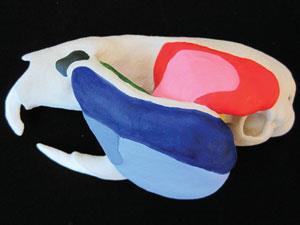
Beyond chemistry, materials are also the limiting factor in 3D printing in other disciplines. Philip Cox is a zoologist at the Hull York Medical School in the UK. He uses a 3D printer to help model skulls and teeth, to understand their biomechanics. ‘We’re finding it really helpful to print out these models so we can get a better handle on what it looks like in three dimensions,’ says Cox. He also has a student who is studying the properties of different tooth shapes, and she is using the 3D printer to make teeth of idealised shapes. ‘Unfortunately the materials we use don’t seem to be strong enough to use the teeth directly in a compression tester,’ Cox says. Instead, they are going to make moulds and cast metal teeth the old fashioned way. ‘There are 3D printers that print in metal available, but they’re very expensive at the moment,’ he says.
Custom kit
But as tools to print one-off, custom-made pieces of lab equipment – given the right materials – 3D printers could be revolutionary. Russell Neches is a graduate student studying phylogenetics, which looks at the relationships between groups of organisms as they have evolved. Neches works in Jonathan Eisen’s lab at the University of California in Davis, US, and turned to a 3D printer to do complicated liquid handling experiments. He had tried to order from robot manufacturers more typically used to making kit for the kind of multi-pipetting Neches needs to extract and dilute DNA from his 50,000+ samples, but none of the commercially available (and very expensive) robots were fast enough.
Neches’ printer cost $1100, and he has used it to print out pipette tips, custom-sized wells on the plates he prints his samples onto and slide-holding carousels for microscopes. ‘What’s unique about 3D printing is it’s actually trivial to make a custom part,’ he says. Neches hopes that 3D printing will ultimately be used to help bring democracy to science, and allow people with less research funding easier access to traditionally expensive equipment.
But before you dash out to try and print a bit of lab kit there is another hurdle to overcome – the design software, known as CAD (computer-aided design). Initially developed for architecture projects, CAD has been notoriously difficult to get to grips with. But the rise of 3D printing and the popularity of those plastic gimmicks has seen this improve, Neches says. ‘A really hard part of the problem [with 3D printing] is the software, and the software is improving rapidly,’ he says.
It is possible to write your own software, and this is what Cronin does. He is aiming high – he wants to see an app store for chemistry grow out of the increased interest in 3D printing. ‘Having better integrated software is going to help open access,’ says Cronin – echoing the open source ethos of the original 3D printers at Fab@Home (developed at Cornell University) and RepRap (from Bath University).
When this might happen is still an open question. For now, Cronin says, ‘it’s going to be enthusiasts for a little while longer’. But as more and more labs cotton on to the idea that a 3D printer could be a cheap way to help them build custom lab kit, run reactions or even democratise access to science, that is likely to change. ‘I think it will explode very soon,’ Cronin says.
Katharine Sanderson is a science writer based in Foix, France
References
2 M S Mannoor et al, Nano Lett., 2013, DOI: 10.1021/nl4007744
3 M D Symes et al, Nat. Chem., 2012, 4, 349 (DOI: 10.1038/nchem.1313)
4 V Dragone et al, Beilstein J. Org. Chem., 2013, 9, 951 (DOI: 10.3762/bjoc.9.109)
5 L Cronin et al, Chem. Sci., 2013, DOI: 10.1039/C3SC51253C
6 I-H Lin et al, Soft Matter, 2013, 9, 1188 (DOI: 10.1039/C2SM27160E)
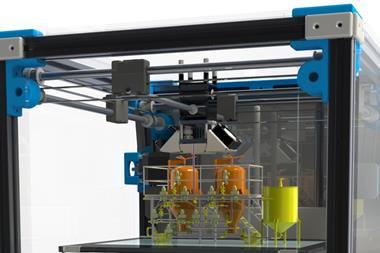


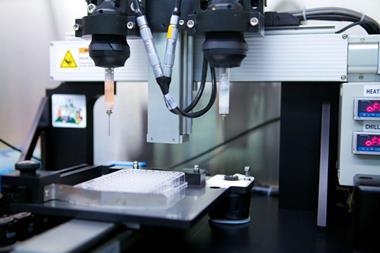








No comments yet